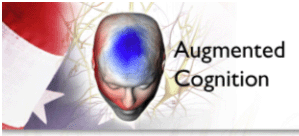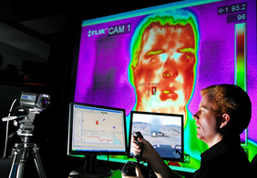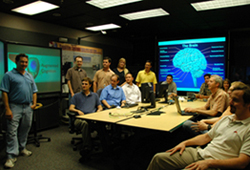NEWS RELEASES
FOR IMMEDIATE RELEASE
August 8, 2007
Cognitive Science and Technology Program becomes Sandia initiative
Labs experience in computing, nanotech, modeling, simulation and surety critical in emerging cognitive revolution
 ALBUQUERQUE, N.M. —Imagine a world where a machine creates a “virtual you” by modeling how you think and your expertise on a subject. Or one where your car’s computer appreciates your driving skills and compensates for your limitations.
ALBUQUERQUE, N.M. —Imagine a world where a machine creates a “virtual you” by modeling how you think and your expertise on a subject. Or one where your car’s computer appreciates your driving skills and compensates for your limitations.
That’s the world Sandia National Laboratories has entered full throttle through its Cognitive Science and Technology Program (CS&T).
A revolution is at hand, says Chris Forsythe, member of the Labs’ cognition research team. It’s not one of just better guns and weapons for national security. Instead, “it’s a revolution of the mind — of how people think and how machines can help people work better.”
Focus on individual
 COGNITION RESEARCHER ROB ABBOTT
COGNITION RESEARCHER ROB ABBOTTSandia researcher Rob Abbott uses a joystick and plays the role of a student in a training exercise driving an amphibious assault vehicle simulator used by the Navy and Marines. The second monitor is an instructor/operator application called CDMTS. In the background is a thermal image of a student’s face used for investigating biometrics to monitor the student in various ways including the level of engagement and focus of attention. (Photo by Randy Montoya)
Download 300dpi JPEG image
A large portion of Sandia’s program today focuses on the uniqueness of the individual interacting with others and with machines. It involves using machines to help humans perform more efficiently and embedding cognitive models in machines so they interact with users more like people interact with one another. The result is the ability for researchers to take advantage of the basic strengths of humans and machines while mitigating the weaknesses of each.
Cognitive projects and research at Sandia span a whole gamut of areas, ranging from student training to assisting with Yucca Mountain licensing, from designing “smart” cars to using video-like games to train military personnel, and from determining how neurons give rise to memory to global terrorist threat detection.
Funding for the research has come from the Office of Naval Research, Sandia’s internal Laboratory Directed Research and Development (LDRD) program, Department of Energy, the Defense Advanced Research Projects Agency (DARPA), and other government agencies. The CS&T program also benefits from collaborations with the University of New Mexico, the MIND Imaging Center in Albuquerque, and most recently the University of Illinois at Urbana-Champaign.
Sandia is a National Nuclear Security Administration (NNSA) laboratory.
The initial decision for Sandia to develop cognitive technologies is based on the belief that “there are numerous positive impacts cognitive systems technologies can have on our national security,” says Russ Skocypec, senior manager of Sandia’s Human, Systems, and Simulation Technologies Department.
Today’s conflicts, he says, are unlike others over the past century. Although all wars are driven by humans, major influences on the outcomes have differed. World War I was a chemists’ war, World War II a physicists’ war, and the Cold War an economic war. Today, he believes, “we are engaged in a human war that is influenced primarily by individual human beings rather than technology or bureaucracy.”
That is why he considers it appropriate for Sandia, a laboratory with national security as its mission, to use its resources to better understand the minds of this country’s adversaries, as well as to use machines to enhance the Labs’ abilities to recognize patterns, deal with massive amounts of data, solve perplexing problems, and perform complex activities.
While Sandia dipped its toes in cognitive research in the late 1990s, the Labs’ real effort in the area started in 2002 when the program won an internally funded LDRD grand challenge. Based in part on the success and path set by the grand challenge in 2005, the former Mission Council — a group that consisted of senior Sandia vice presidents — selected cognitive science and technology (CS&T) as a research focus area for the Labs.
Strategic planning for cognitive science and technology
 COGNITION TEAM AT WORK – (Left to right)
COGNITION TEAM AT WORK – (Left to right)Steve Verzi, Justin Basilico, Charlie Gieseler, Chris Davis (2nd row) Jon Whetzel, Russel Waymire, Ann Speed, Patrick Xavier, Zach Benz (right to back) Matt Glickman, Fred Rothganger, Brian Clark, Wendy Shanefelt, Brian Titu. (Photo by Tiana Chavez)
Download 300dpi JPEG image
During the spring and summer of 2006, the cognition team conducted two investigations. The first looked at what cognitive capabilities exist at Sandia.
The second examined opportunities involving the convergence of Sandia’s initiatives in the areas of cognition, biotechnologies, and nanotechnologies. This led to a Cognitive Science and Technology Plan with three technical objectives — a basic science understanding of the human brain, mind, and behavior; improved human performance; and advanced human-machine systems at all scales.
“The plan is at the level of ‘send a man to the moon’ — beyond the scope of what any one institution can possibly do,” Forsythe says. “It’s a synthesis of ideas. Now, our intent is to home in on a few areas in which the labs can make a unique and profound contribution.”
Forsythe says there are two elements to Sandia’s strategic planning for cognition.
“What makes most sense is for Sandia to select areas where we have unique, collective technical strengths, areas that few others in the world can do as well,” Forsythe says. “These include such capabilities as high performance computing, nanotech, physics-based modeling and simulation, and surety.” That is the first element. (Surety is an engineering discipline that emphasizes methods and technologies enabling assessment and technical solutions for the combined safety, security, and reliability of systems.)
The second involves a focus on opportunities where specific national security problems have a human factor.
John Wagner, manager of Sandia’s Cognitive and Exploratory Systems and Simulations Department, says the new area of research means “profound opportunities exist for the Labs.”
“CS&T’s ambitious direction may not be realized for many decades, but the information required for progress is emerging today,” he says. “It is reasonable to expect future discoveries will become the Nobel-class achievements for the cognitive and neuroscience communities at large in the years to come.”
What is a cognitive system?
The term “cognitive systems” has been used worldwide to identify a variety of programs, initiatives, and technologies. However, so many varied uses have led to ambiguity of meaning. Sandia has established its own definition of cognitive systems: “Cognitive systems consist of technologies that utilize as an essential component one or more computational models of human cognitive processes or the knowledge of specific experts, users, or other individuals.”
Wagner says that cognitive research at Sandia — like most worldwide — is in its infancy. He anticipates that within the next decade research that seems like science fiction today will be a daily part of everyone’s lives. The cognitive revolution will be in full bloom.
“Once that happens, the best of both worlds can happen,” Wagner says. “If we understand human cognition better, we can work together as a nation to reduce tension, find problems before they turn into armed conflict, and to work toward actions that establish and maintain peace worldwide.”
Sandia is a multiprogram laboratory operated by Sandia Corporation, a Lockheed Martin company, for the U.S. Department of Energy’s National Nuclear Security Administration. With main facilities in Albuquerque, N.M., and Livermore, Calif., Sandia has major R&D responsibilities in national security, energy and environmental technologies, and economic competitiveness.
Sandia news media contact: Chris Burroughs, coburro@sandia.gov, (505) 844-0948